Jiayu G4 - once Chinese flagship
Every week on Habré there are reviews of smartphones and it doesn’t matter whether a noname-Chinese is or a representative of the A-brand. But what is a review? - In most cases, the author for a month, or even less testing a smartphone in different living conditions and gives the material. But not everyone is trying to keep up with the novelties, sometimes the run-in device checked by the community is important for a person. After all, it is not known how the phone will work six months later and what pitfalls will emerge during the subsequent operation? Today I will try on a personal example to tell about the use of the Chinese apparatus. The experiment was described by me more than six months ago, the budget flagship of relatively recent times - Jiayu G4 .

Later this model was improved and the Jiayu G2S was released - an equally interesting device that I never had the chance to “touch”. The same characteristics, except for the new display and processor with factory overclocking. To the note: it was in this model that the aluminum base of the smartphone appeared.
Next was the G3 - in the first modification with an MT6577 processor, an HD display and a very clumsy design. Despite the fact that the device was announced earlier than G2S, its entry into the market was constantly postponed, which caused the indignation of the majority of those who were waiting. As a result, while the smartphone reached the customers, its revolutionism came to naught, and even a 2750 mAh battery did not save the voracious processor.
')
It was then that the G3S was born, followed by the G3T. Engineers took into account the mistakes made in the development of the first version of the device and replaced the MT6577 processor with a more powerful MT6589 (4 cores of 1.2 GHz each, Cortex A7, 28 nm), which resulted in an increase in performance with less power consumption.
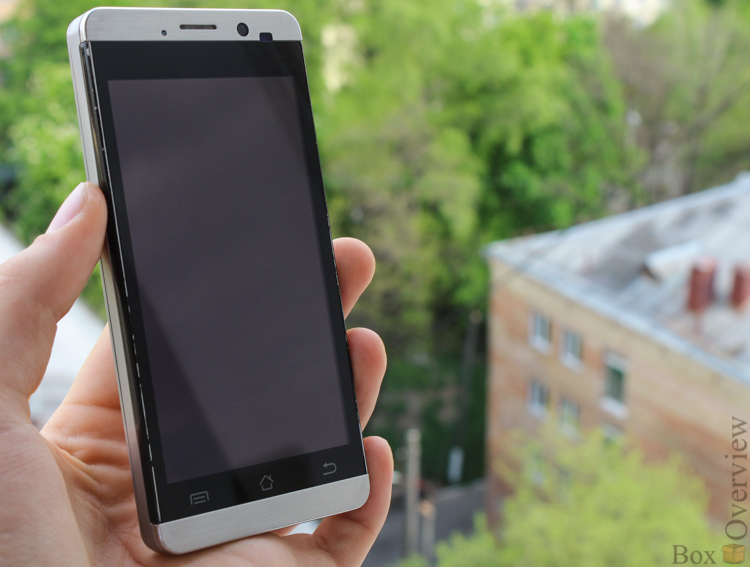
In the fourth generation, the company further improved its flagship: a new design with narrow side frames, an OGS display, an even more capacious battery. But deliveries were again delayed, there were some misunderstandings with different versions (1 GB RAM / 2 GB RAM). As a result, I still managed to snatch the device from the first batch, albeit with minor restrictions (OTG was missing). But the main thing is that the device turned out to be with me. To this day, I use Jiayu G4 and, perhaps, it's time to share my impressions.

In general, the design of the smartphone worked wisely. Its main structural element is the aluminum frame, which perfectly passes various tests of strength, be it a banal twist or a serious fall test from the second floor of a bunk bed.

Errors, of course, were also present, but considering the price, I always closed my eyes to them. The same metal frame in the black version of the smartphone is covered with a regular layer of paint and eventually begins to peel (I have this additionally caused by wearing jeans in my pocket).

The back side is covered with rubberized plastic, which readily collects fingerprints, but still looks great. Only in the area of the USB connector a few millimeters of the cover + several chips, which appeared as a result of falls, broke off.

Some users swore at the location of the "Back" button, saying that it should be on the left and not on the right. In fact, it is a matter of habit, but personally it seems to me that the location of it on the right side is more convenient and logical (and Samsung, with its Galaxy S5, thinks so, yeah). Another thing - the lack of illumination of the block of touch buttons, despite the addiction still miss the occasional, which causes some inconvenience.

Negative temperature "zhuyke" not terrible. The phone worked fine and at -26 degrees Celsius. In terms of impact resistance, the smartphone also does not graze the rear - more than 5 drops (these are those that I remembered at once) on various surfaces from the carpet to the concrete went without significant damage.
One of the main criteria when choosing this smartphone was compact size and in this case, the engineers of the manufacturer managed to achieve significant results. The phone fits well in the hand, there is not even a hint of slipping from the palm. But I still think that the ideal diagonal for a handheld device is 4, well, a maximum of 4.3 inches. IMHO.

The manufacturer also guaranteed the use of a protective cover of Gorilla Glass 2. For a long time, the device did withstand scratches (perhaps they were simply not noticeable), but in the end, careless use without a cover bore fruit and after six months of use the display was covered with small scratches. There are several deep ones - the result of carrying them in one pocket with the keys.
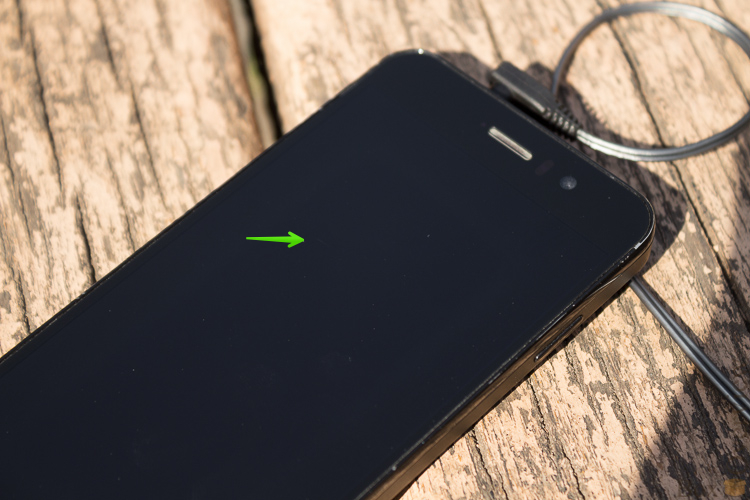
Somewhere after four months of operation, a small white spot appeared in the center of the device. It is noticeable only on a uniform light or dark background. I suspect that this is the very technology OGS "cracked." As a result of the fall, the layers could be unstuck. But despite these flaws, the display is still happy.
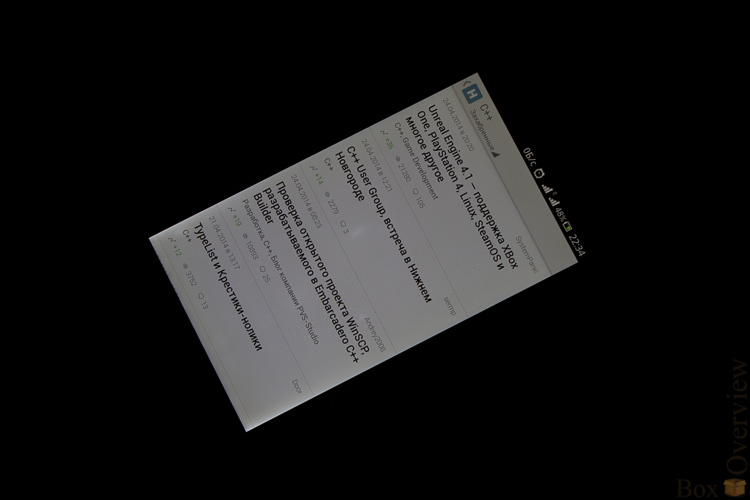
As a full replacement for soap holders or flagship smartphones of famous camera manufacturers in Chinese devices are still not suitable, the reason is the cost of high-quality modules with a large matrix size and good optics, but the signal processing algorithms from the camera also play an important role.
Those who wait while using silent mode in a smartphone will like the LED indication, many manufacturers periodically forget about the bark. Proximity sensors, orientation, gyroscope - everything works correctly, except for the light sensor and the subsequent change in the brightness of the display. I don’t know the problem is the sensor or software itself, but the display brightness changes with jerks, which causes some discomfort (UPD: software problem). As a result, I generally turned off the automatic adjustment of the backlight level of the display and set a quarter of the brightness of the maximum - enough in 90% of cases.
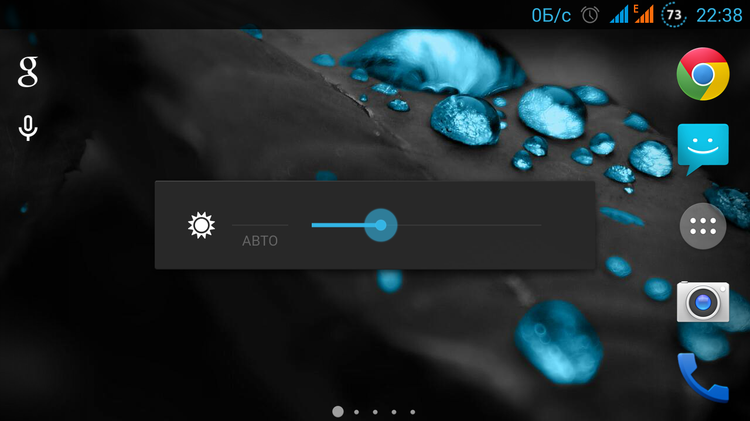
The quality of GPS performance in Jiayu G4 varies from device to device. A kind of guessing game: one smartphone has excellent indicators and detects satellites in seconds, and another for half an hour will not help you to get out of thepriests of people of unknown terrain. However, due to the large population of this model in the CIS, the craftsmen quickly found a way to fix this software jamb.


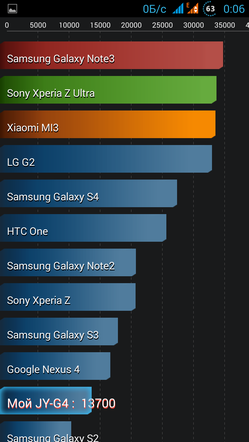
The pre-installed OS is Android 4.2.2 with a custom launcher. True, I immediately "sewed" on the assembly with a "clean" interface, the benefit of the craftsmen on the form brought it to mind. In addition to the installation available: MIUI V5, Lewa OS and many other modifications of Android. On the other hand, there is no popular custom CyanogenMod firmware and no OS updates at all.


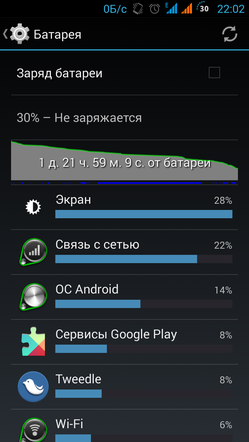
Positive and negative aspects of operation
 Price
Price
 Build quality
Build quality
 Metal carcass
Metal carcass
 Hardware platform (including overall performance and display quality)
Hardware platform (including overall performance and display quality)
 Peeling paint from the frame (only in the black version)
Peeling paint from the frame (only in the black version)
 All the same "Chinese" android
All the same "Chinese" android
 Minor design flaws (touch key backlighting, peeled soft touch coverage in the Micro USB area)
Minor design flaws (touch key backlighting, peeled soft touch coverage in the Micro USB area)
 Mediocre work of GPS and then after dancing with a tambourine
Mediocre work of GPS and then after dancing with a tambourine
At the moment, the original Jiayu G4 (Standart / Advanced) almost disappeared from sale. In March 2014, Jiayu G4C entered the market, a cosmetic upgrade that replaces the MT6589 processor with a newer version of the MT6582. In the latter, a more productive graphics subsystem, Mali-400MP2, is installed, while the cost remains at ~ 150 dollars . In the same way has been updated and G3 .

Less than a month since the last update, the manufacturer announced the G4S model with a processor upgrade to MT6592 (the same 8-core Chinese). The smartphone is again promised in two variations with 1/2 GB RAM and 4/16 GB ROM, respectively. The device is already actively selling and the first owners appear on the forums.

At the same time, the Chinese company continues to develop other lines of its devices. There are already 5-inch devices on the Snapdragon 600 and derivatives thereof on the cheaper MT6592, a budget Jiayu F1 and a design similar to an apple smartphone - G5 . And my previous and very modest G2 evolved to a wealthy G2F while retaining the “tasty” price. With the characteristics and other features of smartphones can be found on the official website Jiayu .
Subject to china-iphone.ru
Our review on habrahabr.ru
IXBT overview
Jiayu G4 on the official website of the manufacturer
I remind you that you can subscribe in order not to miss new reviews and articles on the company’s page (“subscribe” button), or on your favorite social network:
on the company’s page (“subscribe” button), or on your favorite social network:  Vkontakte , in
Vkontakte , in  Google + , in
Google + , in  Twitter
Twitter

Prehistory
My acquaintance with the firm Jiayu and indeed with smartphones on the Android OS began with the budget and not the flagship even for those times Jiayu G2 . In 2012, this device, a review of which we also have on the blog, first of all attracted by its characteristics for a relatively modest price. But most of all, it stood out against the background of other “Chinese phones” due to the ideal ratio of the hardware platform, the diagonal of the display and the size of the battery. Moreover, I still think so, and until recently, I advised this smartphone to anyone familiar with a limited budget. Judge for yourself: IPS-display with a diagonal of 4 inches (800 x 480), 2-core processor (Cortex A9, 40 nm) MT6577, 1 GB RAM (even now budget smartphones from famous manufacturers do not have that amount of RAM), the battery is 2000 mAh .Later this model was improved and the Jiayu G2S was released - an equally interesting device that I never had the chance to “touch”. The same characteristics, except for the new display and processor with factory overclocking. To the note: it was in this model that the aluminum base of the smartphone appeared.
Next was the G3 - in the first modification with an MT6577 processor, an HD display and a very clumsy design. Despite the fact that the device was announced earlier than G2S, its entry into the market was constantly postponed, which caused the indignation of the majority of those who were waiting. As a result, while the smartphone reached the customers, its revolutionism came to naught, and even a 2750 mAh battery did not save the voracious processor.
')
It was then that the G3S was born, followed by the G3T. Engineers took into account the mistakes made in the development of the first version of the device and replaced the MT6577 processor with a more powerful MT6589 (4 cores of 1.2 GHz each, Cortex A7, 28 nm), which resulted in an increase in performance with less power consumption.

In the fourth generation, the company further improved its flagship: a new design with narrow side frames, an OGS display, an even more capacious battery. But deliveries were again delayed, there were some misunderstandings with different versions (1 GB RAM / 2 GB RAM). As a result, I still managed to snatch the device from the first batch, albeit with minor restrictions (OTG was missing). But the main thing is that the device turned out to be with me. To this day, I use Jiayu G4 and, perhaps, it's time to share my impressions.
Body materials, appearance
The absence of any logos on the front of the device suggests an idea of its similarity with the iPhone 5. Yes, many will note the absence of the Home button, but I just state a fact - most of my friends really recognized the apple smartphone in Jiayu G4.
In general, the design of the smartphone worked wisely. Its main structural element is the aluminum frame, which perfectly passes various tests of strength, be it a banal twist or a serious fall test from the second floor of a bunk bed.

Errors, of course, were also present, but considering the price, I always closed my eyes to them. The same metal frame in the black version of the smartphone is covered with a regular layer of paint and eventually begins to peel (I have this additionally caused by wearing jeans in my pocket).

The back side is covered with rubberized plastic, which readily collects fingerprints, but still looks great. Only in the area of the USB connector a few millimeters of the cover + several chips, which appeared as a result of falls, broke off.

Some users swore at the location of the "Back" button, saying that it should be on the left and not on the right. In fact, it is a matter of habit, but personally it seems to me that the location of it on the right side is more convenient and logical (and Samsung, with its Galaxy S5, thinks so, yeah). Another thing - the lack of illumination of the block of touch buttons, despite the addiction still miss the occasional, which causes some inconvenience.

Negative temperature "zhuyke" not terrible. The phone worked fine and at -26 degrees Celsius. In terms of impact resistance, the smartphone also does not graze the rear - more than 5 drops (these are those that I remembered at once) on various surfaces from the carpet to the concrete went without significant damage.
One of the main criteria when choosing this smartphone was compact size and in this case, the engineers of the manufacturer managed to achieve significant results. The phone fits well in the hand, there is not even a hint of slipping from the palm. But I still think that the ideal diagonal for a handheld device is 4, well, a maximum of 4.3 inches. IMHO.
Display, camera and sensors
The first impressions of the 4.7-inch IPS-matrix were simply excellent, for the most part this is the merit of the OGS technology. The scheme is not new and in more detail I talked about it in a full review (the main advantage is excellent behavior in the sun), but branded devices for the same price still use the version with separate display and touch layer.
The manufacturer also guaranteed the use of a protective cover of Gorilla Glass 2. For a long time, the device did withstand scratches (perhaps they were simply not noticeable), but in the end, careless use without a cover bore fruit and after six months of use the display was covered with small scratches. There are several deep ones - the result of carrying them in one pocket with the keys.

Somewhere after four months of operation, a small white spot appeared in the center of the device. It is noticeable only on a uniform light or dark background. I suspect that this is the very technology OGS "cracked." As a result of the fall, the layers could be unstuck. But despite these flaws, the display is still happy.

As a full replacement for soap holders or flagship smartphones of famous camera manufacturers in Chinese devices are still not suitable, the reason is the cost of high-quality modules with a large matrix size and good optics, but the signal processing algorithms from the camera also play an important role.
Those who wait while using silent mode in a smartphone will like the LED indication, many manufacturers periodically forget about the bark. Proximity sensors, orientation, gyroscope - everything works correctly, except for the light sensor and the subsequent change in the brightness of the display. I don’t know the problem is the sensor or software itself, but the display brightness changes with jerks, which causes some discomfort (UPD: software problem). As a result, I generally turned off the automatic adjustment of the backlight level of the display and set a quarter of the brightness of the maximum - enough in 90% of cases.

Communication capabilities
Two SIM cards are connected to one radio module - the standard scheme for most Chinese devices and when one SIM card is working, the second one goes into standby mode. The connection is generally stable, no communication breaks in daily use have been noticed.The quality of GPS performance in Jiayu G4 varies from device to device. A kind of guessing game: one smartphone has excellent indicators and detects satellites in seconds, and another for half an hour will not help you to get out of the
Hardware platform, overall performance
Like most Chinese smartphones in 2013, the Jiayu G4 is equipped with SoC MT6589, which I described in some detail in the full review, and send you there , respectively . After almost a year my preferences have not changed, I did not start playing heavy games on the phone and therefore my smartphone still satisfies my needs. Just in case, I repeated the AnTuTu Benchmark test in modern realities.


The pre-installed OS is Android 4.2.2 with a custom launcher. True, I immediately "sewed" on the assembly with a "clean" interface, the benefit of the craftsmen on the form brought it to mind. In addition to the installation available: MIUI V5, Lewa OS and many other modifications of Android. On the other hand, there is no popular custom CyanogenMod firmware and no OS updates at all.
Autonomy
A battery with a capacity of 3 A * h, an economical processor and truly correct, as for such a diagonal, the display resolution is felt. I will not speak for others, but in my mode of operation where social services prevail. networks (news and chats) and other Internet sites the device works stably for two days. I don’t use 3G, as there’s still a problem in Ukraine (both in terms of price and coverage), but Wi-Fi is constantly active.


Results
Writing this experience made me want to switch to another OS and, accordingly, a smartphone, so it turned out a kind of summing up. Jiayu G4 faithfully served its ~ 10 months surviving all my careless use. The device, which fully meets its price and needs, the device with a practical design and durable construction, a good technical base and autonomy. So if you are faced with the choice of a full-fledged smartphone at an adequate price, you can still safely recommend the Quartet, in any variation.Positive and negative aspects of operation
 Price
Price Build quality
Build quality Metal carcass
Metal carcass Hardware platform (including overall performance and display quality)
Hardware platform (including overall performance and display quality) Peeling paint from the frame (only in the black version)
Peeling paint from the frame (only in the black version) All the same "Chinese" android
All the same "Chinese" android Minor design flaws (touch key backlighting, peeled soft touch coverage in the Micro USB area)
Minor design flaws (touch key backlighting, peeled soft touch coverage in the Micro USB area) Mediocre work of GPS and then after dancing with a tambourine
Mediocre work of GPS and then after dancing with a tambourineAt the moment, the original Jiayu G4 (Standart / Advanced) almost disappeared from sale. In March 2014, Jiayu G4C entered the market, a cosmetic upgrade that replaces the MT6589 processor with a newer version of the MT6582. In the latter, a more productive graphics subsystem, Mali-400MP2, is installed, while the cost remains at ~ 150 dollars . In the same way has been updated and G3 .

Less than a month since the last update, the manufacturer announced the G4S model with a processor upgrade to MT6592 (the same 8-core Chinese). The smartphone is again promised in two variations with 1/2 GB RAM and 4/16 GB ROM, respectively. The device is already actively selling and the first owners appear on the forums.

At the same time, the Chinese company continues to develop other lines of its devices. There are already 5-inch devices on the Snapdragon 600 and derivatives thereof on the cheaper MT6592, a budget Jiayu F1 and a design similar to an apple smartphone - G5 . And my previous and very modest G2 evolved to a wealthy G2F while retaining the “tasty” price. With the characteristics and other features of smartphones can be found on the official website Jiayu .
useful links
Talk on w3bsit3-dns.comSubject to china-iphone.ru
Our review on habrahabr.ru
IXBT overview
Jiayu G4 on the official website of the manufacturer
I remind you that you can subscribe in order not to miss new reviews and articles
 on the company’s page (“subscribe” button), or on your favorite social network:
on the company’s page (“subscribe” button), or on your favorite social network:  Vkontakte , in
Vkontakte , in  Google + , in
Google + , in  Twitter
TwitterSource: https://habr.com/ru/post/215951/
All Articles